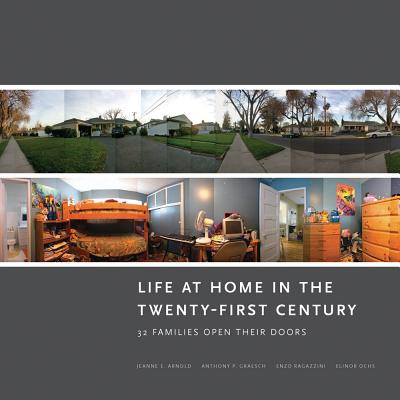Life at Home in the Twenty-First Century: 32 Families Open Their Doors
Jeanne E. Arnold

This book presents some really interesting academic work. I had heard of it a while ago, but had forgotten until Elise brought the book home–one of her professors had discussed the work in a class. The authors are anthropologists at UCLA who undertook a painstaking study of the material home lives of 32 self-identified middle class families in LA over a couple of weeks. Just as anthropologists studying ancient cultures try to derive knowledge about them by the material remains that we can find, so these anthropologists studied modern American life through the specific lens of the houses of these families and the objects inside them. One of the cool things about the study is that the authors made a point of recording a rich catalog of data–blueprints, comprehensive photographs with tagged objects and object counts by class and room, time-use observations of the family members themselves–even if it wasn’t necessarily germane to their immediate research interests. The goal was to establish a valuable dataset that future researchers could mine in all kinds of ways.
The book is brief so you should really read it yourself, but I’ll mention some of the interesting findings–which are in line with many of my personal preconceptions:
-Families made heavy use of processed convenience foods in preparing dinner, yet these actually saved very little food preparation time–about 10 minutes per meal on average. The main time effect of these foods is to save the parents the effort of planning menus for the week.
-Despite the fact that all of these families live in LA, and that many of them had extensively renovated outdoor spaces, the total amount of time spent outside at home by all family members was effectively a rounding error.
-High (self-assessed) levels of clutter were associated with higher stress levels of the mothers (not fathers) as measured by cortisol levels. (It is not clear to me, at least from the presentation in the book, if the association is causal, or if so, in the implied direction. It could be that stressed mothers tend to be more bothered by clutter.)
-The families in the study ate meals together even less frequently than averages reported in national survey data (which were quite low in the first place).
The book is heavily focused on photographs, and I think one of the most interesting parts of reading it was just its role as an antidote to the unrealistic depictions of homes we see in the media. This is a truth that I think I and many others have digested regarding depictions of bodies and human beauty in media, but it is striking how analogous the situation is with depictions of living spaces. It is a little funny at first to see a coffee table book filled with pictures of regular, messy houses.